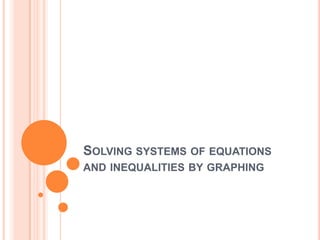
Solving Systems of Equations and Inequalities by Graphing
- 1. SOLVING SYSTEMS OF EQUATIONS AND INEQUALITIES BY GRAPHING
- 2. SYSTEMS OF EQUATIONS Remember that a system of equations is a group of two or more equations that we solve at the same time A point is a solution of the system if it works when substituted into each equation. For example, the solution to the system above is (2,0).
- 3. REVIEW OF GRAPHS OF SYSTEMS OF LINEAR EQUATIONS When working with two equations in two variables, there are three possibilities for their graphs: The lines can intersect and have one solution (x, y). The lines can be parallel and have no solution. The lines can coincide and have infinitely many solutions.
- 4. BUT NOW… We want to start working with systems that don’t just have linear equations. We will still graph our functions and look for the point(s) of intersection when we want to solve our systems.
- 5. EXAMPLE 1 Let’s solve the system below by graphing: Graph each function on the same coordinate plane:
- 6. EXAMPLE 1 CONTINUED Look at the graph and identify the points of intersection: There are two points of intersection, so our system has two solutions: (-1, 2) and (1, 2) You can substitute both points into your equations and get true statements. This is an easy way to check your work!
- 7. TO SOLVE USING YOUR CALCULATOR Put your equations in y =. abs( can be found by pressing 2nd 0, and choosing the first option. Graph to see the number of solutions.
- 8. TO SOLVE USING YOUR CALCULATOR…CONTINUED To find the first point of intersection, press 2nd TRACE, and choose #5 (intersect). Move your cursor to the left of the first intersection and press enter. Move to the right and press enter. Then press enter a third time to see the coordinates: Repeat the process to find the second solution at (1, 2).
- 9. EXAMPLE 2 Let’s solve: First, recognize that the first equation is an absolute value graph (a V) that has been shifted right 2 units and down 1 unit. Then, solve the second equation for y: y = x + 1. Finally, graph.
- 10. EXAMPLE 2 CONTINUED The graphs intersect ONCE. The only solution to the system is (0, 1). Notice that you can substitute your point into both equations and get a true statement.
- 11. EXAMPLE 3 Let’s solve: First, solve the first equation for y to get . Then, recognize that this is an absolute value graph (a V) that has been shifted left 2 units, down 2 units, and reflected across the xaxis. The second equation is a line. Now, graph.
- 12. EXAMPLE 3 CONTINUED The graphs don’t intersect. The solution is that there is no solution. This means there is NO point that exists that would give you a true statement for both equations.
- 13. SUMMARY OF STEPS Graph each function in your system. It would be most helpful if you solve for y in each case. Identify the point(s) of intersection of the graphs of your functions. State your solution(s). Check them by substituting back into your system of equations.
- 14. SYSTEMS OF INEQUALITIES Remember that a system of inequalities is a group of two or more equations that we solve at the same time: Here’s a review of what the symbols tell us to do: >: <: : : dashed line, shaded above boundary line dashed line, shaded below boundary line solid line, shaded above boundary line solid line, shaded above boundary line
- 15. SYSTEMS OF INEQUALITIES CONTINUED We will graph each boundary line just as we did before, and we will put each of them on the same coordinate plane. Where the shaded regions all overlap will represent the solution of our system—meaning that any point from the shared region will produce a true solution when substituted into all of the inequalities in our system
- 16. EXAMPLE 1 Let’s solve the system below by graphing: The first will be a dashed line shaded above. (in red) The second will be a solid line shaded below. (in blue) Graph each inequality on the same coordinate plane. The area where they overlap is the solution.
- 17. EXAMPLE 1 CONTINUED The region where both shaded areas overlap represents the solution to our system. Notice the region occurs in both Quadrant II and in Quadrant III. Any point chosen from this area will produce true statements when substituted into both inequalities.
- 18. EXAMPLE 2 Solve the system by graphing: The first is an absolute value function; use a solid line and shade above. (in red) The second is a horizontal line; use a dashed line and shade below. (in blue) Since the shaded regions don’t overlap, this system has no solution.
- 19. EXAMPLE 3 Solve the system by graphing: The first is a vertical line. Use a solid line and shade to the right. The second is a vertical line. Use a solid line and shade to the left. The third is a diagonal line. Solve for y. Then use a solid line and shade below. The solution region is shaded the darkest.
- 20. UP NEXT… In Lessons 4 and 5, you will study a real-world application of solving systems of linear equations and inequalities!